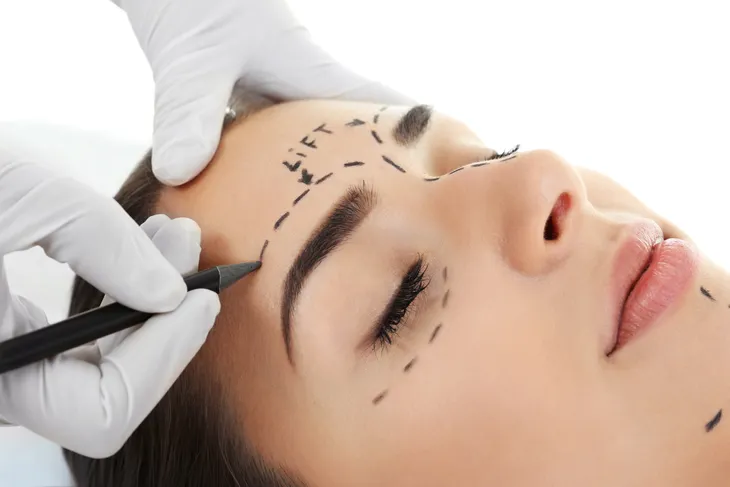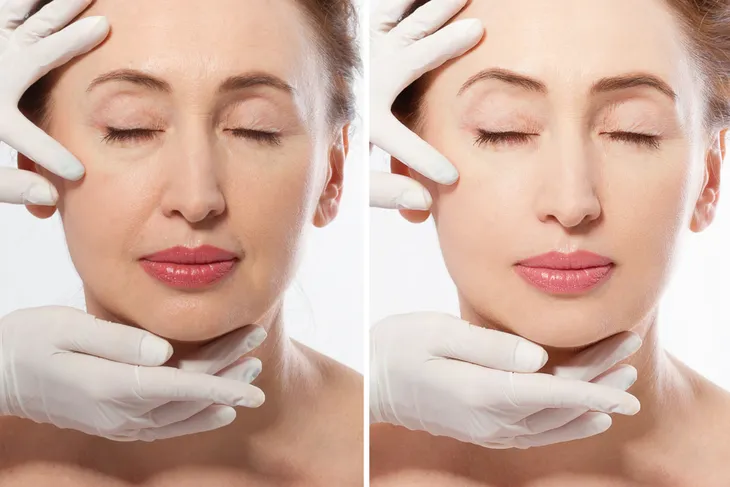Aging is a natural part of growing older, but there are ways to prevent aging early by implementing proper diet habits, exercise routines, and skincare regimes into your lifestyle. If you’ve noticed signs of aging, however, and are looking for ways to reduce its effects, there are a few procedures that can revive a more youthful appearance.
A brow lift is one of these ways to restore a youthful appearance by reversing a heavy brow line or wrinkled forehead. These signs of aging can make you look older than you feel by making you appear tired, upset, or stressed. If you’re considering a brow lift to rejuvenate the upper face, it’s important to look at both the surgical and non-surgical options available as well as the pros and cons of each.
What Is a Surgical Brow Lift?
According to the Orange Country Facial Plastic Surgery Clinic, a surgical brow or forehead lift is “intended to reposition the tissue of the upper face to a higher, more youthful location and reduce excess skin.” There are different forms of surgical brow lifts, but often the most common is the endoscopic brow lift, which involves a few small incisions to minimize scarring.
Some of the concerns that a surgical brow lift addresses include horizontal forehead lines, sagging skin, crow’s feet, and vertical wrinkles between the eyebrows. This procedure may also help to lift drooping eyelids.
What Is a Non-Surgical Brow Lift?
A non-surgical brow lift, on the other hand, is a less invasive way to achieve a similar look. According to Aedit.com, “instead of reconstructing the brow region, this procedure relies on chemicals to reshape and reform the face into a more youthful appearance.”
While a non-surgical brow lift cannot remove excess skin, it can smooth wrinkles, improve skin texture, and enhance volume along the forehead and browline through the use of dermal fillers or cosmetic injectables.
Surgical Brow Lift: Pros & Cons
Pro: Permanent Results
A major pro to a surgical brow lift is that the results will be permanent and immediate. While the procedure may be more invasive than the non-surgical method, it may be worth it if you want long-term results without the need for touch-ups or maintenance appointments.
Con: More Expensive
Since the surgical route is more invasive and requires incisions and the work of a surgeon, it is naturally more expensive than the non-surgical option. This procedure typically ranges in cost between $3700 up to $5000 depending on the work that needs to be done. The non-surgical route, on the other hand, will typically cost around $800+ depending on how many syringes are required.
Pro: Dramatic, Immediate Results
Another positive point with the surgical brow lift is that the results will be much more dramatic since the procedure can also remove excess skin and reposition underlying muscle and tissue. While the non-surgical brow lift may not be invasive, it can take multiple appointments to get the desired result. The results with the surgical brow lift are also immediate, whereas the non-surgical route may take 4 to 6 weeks to fully see results.
Con: Longer Recovery Period
A con to keep in mind with the surgical route is that it will require a longer recovery period. The initial wound will take around 10-24 days to heal, but it could take months for the patient to have a complete recovery. Most patients feel comfortable resuming normal activity after one week.
Non-Surgical Brow Lift: Pros & Cons
Pro: Noninvasive
One of the biggest pros with the non-surgical brow lift is that it’s non-invasive and utilizes chemicals to produce a similar, but less dramatic effect as the surgical route. It will make the forehead appear refreshed and smooth any fine lines or wrinkles without the recovery period of the surgical route.
Con: Temporary Results
A con to keep in mind with the non-surgical brow lift is that the results will be temporary and keeping the same refreshed, youthful look will require touch-ups and maintenance treatments every eight months. It may also take multiple appointments to get the initial desired effect that you’re looking for.
Pro: Shorter Recovery Period
The recovery period for the non-surgical brow lift is quite minimal. It’s suggested that patients should avoid lying down or manipulating the treatment area for 3 to 4-hours after treatment, but can resume regular daily activity after 24-hours.
Con: Potential for Variance
Another potential side effect of the non-surgical brow lift is that Botox can potentially cause droopy eyelids or the appearance of an overly arched brow if not injected properly. To avoid this risk, it’s important to do research on the professional you’re getting the treatment from to ensure they have positive reviews and experience with this specific type of brow lift.
How to Choose
Now that you know both the pros and cons of the surgical vs. non-surgical brow lift, it’s time to make a decision on what option is best suited for you. It’s important to weigh your options with the help of a professional before making a final decision. A consultation can allow a professional to examine your concerns and help you determine the best course of action for your specific needs.
The second step will be to figure out your budget, lifestyle needs, and desired results. If you aren’t looking to make a major investment and don’t have the time for a longer recovery period, the non-surgical route could be just what you need. On the other hand, if you’re looking for more dramatic, permanent results without the commitment of maintenance appointments, the surgical option might be the better option.














